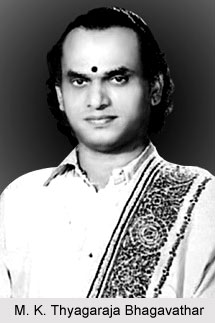 M. K. Thyagaraja Bhagavathar, popularly known as MKT was born in the month of January in 1910. He was a legendary singing star who reigned supreme in Tamil theatre and cinema after S. G. Kittappa. M. K. Thyagaraja Bhagavathar was born in Tiruchchirapalli. Mayavaram Krishnamurthy Thyagaraja Bhagavathar was an ordinary goldsmith`s son; he had no formal education and no training in music either. However, he was obsessed with theatre, which in his time was mostly musical. Early in his boyhood, he entered local bhajan groups and started singing in temples. At the age of 18, he joined a theatre troupe and was paired with S. D. Subbalakshmi, who was already an established actress. But M. K. Thyagaraja Bhagavathar had a great presence himself, sporting long hair and earrings. The couple became an instant hit and the company toured all over Tamil Nadu, Ceylon, Singapore, and Malaya. The pair started with their most successful play Pavalakkodi. This was an episode in the Mahabharata wholly of local origin. M. K. Thyagaraja Bhagavathar was acting the role of Arjuna at that play.
M. K. Thyagaraja Bhagavathar, popularly known as MKT was born in the month of January in 1910. He was a legendary singing star who reigned supreme in Tamil theatre and cinema after S. G. Kittappa. M. K. Thyagaraja Bhagavathar was born in Tiruchchirapalli. Mayavaram Krishnamurthy Thyagaraja Bhagavathar was an ordinary goldsmith`s son; he had no formal education and no training in music either. However, he was obsessed with theatre, which in his time was mostly musical. Early in his boyhood, he entered local bhajan groups and started singing in temples. At the age of 18, he joined a theatre troupe and was paired with S. D. Subbalakshmi, who was already an established actress. But M. K. Thyagaraja Bhagavathar had a great presence himself, sporting long hair and earrings. The couple became an instant hit and the company toured all over Tamil Nadu, Ceylon, Singapore, and Malaya. The pair started with their most successful play Pavalakkodi. This was an episode in the Mahabharata wholly of local origin. M. K. Thyagaraja Bhagavathar was acting the role of Arjuna at that play.
Career in Theatre for M. K. Thyagaraja Bhagavathar
M. K. Thyagaraja Bhagavathar`s best movies were historical. Some of them can be mentioned as Ambikapati in 1937, in which he played the eponymous hero and sang Bajanai seivai maname i.e. "Sing a bhajan, O mind", and Ashok Kumar in 1941, where he M. K. Thyagaraja Bhagavathar acted the emperor`s son. Sivakavi in 1943 had twenty-nine songs, among which he sang nineteen. His invocation of the goddess, "Amba manam kanindu unadu kadaikkan par i.e. "Amba, may your mind relent and your benign eyes fall on me", was later inscribed on a suburban temple in Chennai. Haridas in 1944 ran continuously in Chennai for a record of three years. Thyagaraja`s melodious singing made his productions and films the rage. The songs by M. K. Thyagaraja Bhagavathar were on everyone`s lips, including young or old, trained or untrained in music, urban or rural, educated or uneducated. Cinema in those days rendered a great service in propagating classical Carnatic music to a degree that it could be well termed the pop music of its time, if one went by the measure of its popularity among the masses. M. K. Thyagaraja Bhagavathar stood out by his signal contribution.
At the peak of M. K. Thyagaraja Bhagavathar`s career, he was charged with involvement in a conspiracy to abet the murder of a yellow journalist, Lakshmikantan who was the editor of lndu nesan. Eventually Thyagaraja Bhagavathar was arrested with co-actor N. S. Krishnan, and jailed from 1945 to 1947. It is believed that his absence from the film industry provided a window for Dravidian atheist movement to move in and establish themselves in the Tamil film industry. On his release, M. K. Thyagaraja Bhagavathar started his own film production company and contracted the best of talents but to no avail. All these films flopped miserably. Times had changed. There was no audience any more for his kind of music or his type of movies with themes of bhakti, sin, and repentance.
M. K. Thyagaraja Bhagavathar died on 1 November 1959 due to cirrhosis. MKT is widely regarded as the first superstar of Tamil cinema as well. MKT`s Golden voice remains unparalleled in Tamil Cinema and his songs are still popular among music Connoisseur.




















